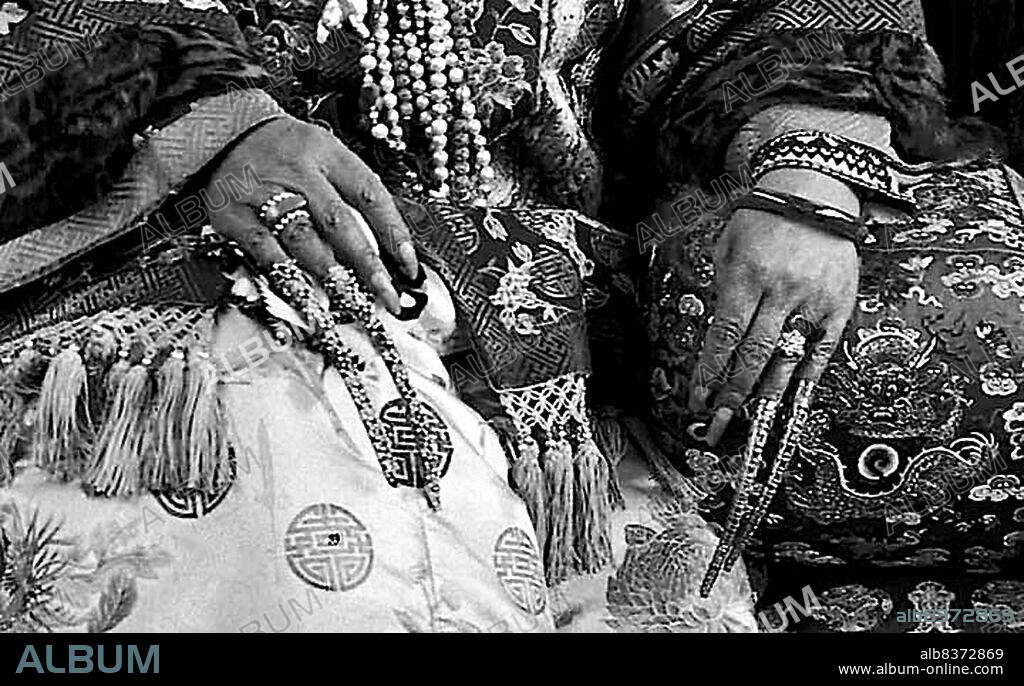alb8372869
China: Detail of elaborate golden and jewelled zhijia tao< / i> or finger stalls worn by Cixi, Empress of China (r. 1861-1908), c. 1900

|
Añadir a otro lightbox |
|
Añadir a otro lightbox |



¿Ya tienes cuenta? Iniciar sesión
¿No tienes cuenta? Regístrate
Compra esta imagen.
Selecciona el uso:

Título:
China: Detail of elaborate golden and jewelled zhijia tao< / i> or finger stalls worn by Cixi, Empress of China (r. 1861-1908), c. 1900
Descripción:
Ver traducción automática
Western descriptions of Chinese emperors, royalty and nobles often mention fingernails long enough to mark the person above any possibility of manual labor. These fingernail protectors, or guards, might be worn as a single jewel on the hand or in multiple sets.
. According to the San Diego Museum of Art: 'Fingernail protectors were worn by a very elite groupManchu court ladies of the late Qing dynasty. Although scholars of Chinese costumes usually date fingernail protectors to the Qing dynasty, they are in fact characteristic only of the late 19th century. Portraits of early Qing court ladies show natural fingernails. Late Qing rulers, however, pursued a life of absolute luxury. For example, photographs and portraits of Empress Jixi (1835-1908) show her wearing two or three nail shields on each of her handsa sign of her ability to rely upon servants to carry out any of her wishes, as she herself could perform no manual tasks'.
. The wearing of fingernail protectors was specifically associated with the Manchurian high culture of the Qing Dynasty. Han men were forced by law to wear Manchu clothing and to groom themselves by Manchu custom, whereas Han women were free to continue wearing traditional Han fashions. Manchu women felt that long fingernails were a status symbol they protected with fingernail covers that might be finely carved and inlayed with gold silver and gem.
. According to the San Diego Museum of Art: 'Fingernail protectors were worn by a very elite groupManchu court ladies of the late Qing dynasty. Although scholars of Chinese costumes usually date fingernail protectors to the Qing dynasty, they are in fact characteristic only of the late 19th century. Portraits of early Qing court ladies show natural fingernails. Late Qing rulers, however, pursued a life of absolute luxury. For example, photographs and portraits of Empress Jixi (1835-1908) show her wearing two or three nail shields on each of her handsa sign of her ability to rely upon servants to carry out any of her wishes, as she herself could perform no manual tasks'.
. The wearing of fingernail protectors was specifically associated with the Manchurian high culture of the Qing Dynasty. Han men were forced by law to wear Manchu clothing and to groom themselves by Manchu custom, whereas Han women were free to continue wearing traditional Han fashions. Manchu women felt that long fingernails were a status symbol they protected with fingernail covers that might be finely carved and inlayed with gold silver and gem.
Crédito:
Album / Universal Images Group / Pictures From History
Autorizaciones:
Modelo: No - Propiedad: No
¿Preguntas relacionadas con los derechos?
¿Preguntas relacionadas con los derechos?
Tamaño imagen:
5100 x 3152 px | 46.0 MB
Tamaño impresión:
43.2 x 26.7 cm | 17.0 x 10.5 in (300 dpi)
Palabras clave:
1900 • ASIA • ASIATICO • CHINO • DINASTIA CH'ING • EMPERATRIZ • ESTILO • FOTOGRAFIA • GOBERNANTE • HEMBRA • JOYERIA • MODA • MONARQUIA • MUJER • MUJERES • REALEZA • REINA
 Pinterest
Pinterest Twitter
Twitter Facebook
Facebook Copiar enlace
Copiar enlace Email
Email
